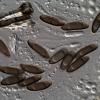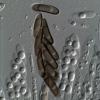
31-12-2025 19:27
Collected from loamy soil, at waterside (completel

30-12-2025 16:44
Pascal DucosBonjour,Une anamorphe rose stipitée, très nombre

30-12-2025 17:14
 Bernard CLESSE
Bernard CLESSE
Bonjour à toutes et tous,Pourriez-vous aider Albe

29-12-2025 10:15
Hulda Caroline HolteHello, I found and collected this propoloid ascom

30-12-2025 09:04
Hello.A Pyrenomycete sprouting sparsely but very d

29-12-2025 17:44
Isabelle CharissouBonjour,J'aimerais savoir si d'autres personnes au

12-11-2021 00:03
Lepista ZacariasHi everybody,A week ago in my fiels trip I noticed
Endoxyla from Cornwall?
Paul Cannon,
29-12-2014 18:21
See http://fungi.myspecies.info/all-fungi/endoxyla-sp-p1717 for a full description and more images.
Jacques Fournier,
29-12-2014 19:10

Re : Endoxyla from Cornwall?
Hi Paul,
good to hear you don't give up mycology because of the coming New Year celebrations!
Your tricky fungus indeed does not key out in Untereiner's key. I wonder if ascospores are really septate of if the septum is not just the boundary between two guttules. As they apparently lack a germ pore and are in fusiform asci, Endoxyla might not be the good genus. Because of the long stipitate asci, I would consider some diatrypaceous genus like Barrmaelia, though very rotten wood is not a typical substrate. Is the wood surface somewaht blackened?
I also discovered on your website your unnamed Endoxyla with ascospores sometimes stuck by pairs. Did you consider Synaptospora, a genus where such ascospore arrangement occurs?
Cornwall is definitely a fungus-rich region, you are fortunate!
All my best for 2015!
Jacques
good to hear you don't give up mycology because of the coming New Year celebrations!
Your tricky fungus indeed does not key out in Untereiner's key. I wonder if ascospores are really septate of if the septum is not just the boundary between two guttules. As they apparently lack a germ pore and are in fusiform asci, Endoxyla might not be the good genus. Because of the long stipitate asci, I would consider some diatrypaceous genus like Barrmaelia, though very rotten wood is not a typical substrate. Is the wood surface somewaht blackened?
I also discovered on your website your unnamed Endoxyla with ascospores sometimes stuck by pairs. Did you consider Synaptospora, a genus where such ascospore arrangement occurs?
Cornwall is definitely a fungus-rich region, you are fortunate!
All my best for 2015!
Jacques
Paul Cannon,
29-12-2014 19:36
Re : Endoxyla from Cornwall?
No, there is no evidence of blackening on the surface, which tends to rule out Barrmaelia (and also Clypeosphaeria which I had considered). I think the septa are genuine, but it is strange that so few of the spores develop them. The lack of a germ pore argues against Endoxyla as you say, but some of the literature suggests that they are very inconspicuous and may not always be present. The material I have is sparse and we will need to find more.
The other "Endoxyla" was also found in southern Norway during our visit to Bjorn. I don't think this is a Synaptospora, but there is an apparently new one of these from Cornwall as well - see http://fungi.myspecies.info/all-fungi/synaptospora-sp-p1437
Thank you for all your suggestions, you're right that Cornwall is a rather special place for fungi. We must tempt you to visit some day....
Best wishes, Paul
The other "Endoxyla" was also found in southern Norway during our visit to Bjorn. I don't think this is a Synaptospora, but there is an apparently new one of these from Cornwall as well - see http://fungi.myspecies.info/all-fungi/synaptospora-sp-p1437
Thank you for all your suggestions, you're right that Cornwall is a rather special place for fungi. We must tempt you to visit some day....
Best wishes, Paul




